Animal Kingdom MCQ Solved Paper for IBPS Clerk
Thursday 9th of March 2023

Sharing is caring
1. Which of the following is a chordate feature and not shared by the non-chordates ?
A. Metamerism
B. Axial organization
C. Bilateral symmetry
D. Pharyngeal gill slits
Answer : D
A. Metamerism
B. Axial organization
C. Bilateral symmetry
D. Pharyngeal gill slits
Answer : D
2. Which of the following possesses electric organs and belongs to class chondrichthyes?
A. Torpedo
B. Petromyzon
C. Trygon
D. Exocoetus
Answer : A
A. Torpedo
B. Petromyzon
C. Trygon
D. Exocoetus
Answer : A
3. Refer the figures A, B, C and D given below. Which of the following options shows the correct name of the animals shown by the figures A, B, C and D ?

A. A – Locust, B – Scorpion, C – Prawn, D – Pila
B. A – Locust, B – Prawn, C – Scorpion, D – Pila
C. A – Locust, B – Scorpion, C – Prawn, D – Snail
D. A – Butterfly, B – Scorpion, C – Prawn, D – Pila
Answer : A

A. A – Locust, B – Scorpion, C – Prawn, D – Pila
B. A – Locust, B – Prawn, C – Scorpion, D – Pila
C. A – Locust, B – Scorpion, C – Prawn, D – Snail
D. A – Butterfly, B – Scorpion, C – Prawn, D – Pila
Answer : A
4. Which of the following animal's body is covered by calcareous shell and unsegmented with a distinct head, muscular foot, and visceral hump?
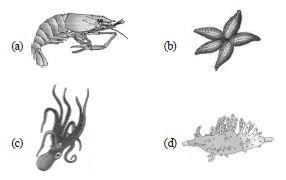
A. Click to check answer
B. Click to check answer
C. Click to check answer
D. Click to check answer
Answer : C

A. Click to check answer
B. Click to check answer
C. Click to check answer
D. Click to check answer
Answer : C
5. Which of the following statement(s) is/are correct regarding phylum coelenterata?
(i) They are aquatic, mostly marine, sessile or freeswimming, radially symmetrical animals.
(ii) They have a central gastro-vascular cavity with a single opening called hypostome.
(iii) Digestion is extracellular and intracellular.
(iv) Examples are Sycon, Spongilla and Euspongia.
A. (i) and (ii)
B. (i) and (iv)
C. (i), (ii) and (iii)
D. All of these
Answer : C
(i) They are aquatic, mostly marine, sessile or freeswimming, radially symmetrical animals.
(ii) They have a central gastro-vascular cavity with a single opening called hypostome.
(iii) Digestion is extracellular and intracellular.
(iv) Examples are Sycon, Spongilla and Euspongia.
A. (i) and (ii)
B. (i) and (iv)
C. (i), (ii) and (iii)
D. All of these
Answer : C
6. Which of the following phylum is being described by the given statements?
(i) These are primitive multicellular animals and have cellular level of organization.
(ii) Digestion is intracellular.
(iii) They have a water transport or canal system.
(iv) They reproduce asexually by fragmentation and sexually by formation of gametes.
A. Porifera
B. Ctenophora
C. Coelenterata
D. Platyhelminthes
Answer : A
(i) These are primitive multicellular animals and have cellular level of organization.
(ii) Digestion is intracellular.
(iii) They have a water transport or canal system.
(iv) They reproduce asexually by fragmentation and sexually by formation of gametes.
A. Porifera
B. Ctenophora
C. Coelenterata
D. Platyhelminthes
Answer : A
7. Which of the following statements is without exception in sponges ?
A. They all have calcareous spicules.
B. They have high regenerative power.
C. They are found only in marine water.
D. They are all radially symmetrical.
Answer : B
A. They all have calcareous spicules.
B. They have high regenerative power.
C. They are found only in marine water.
D. They are all radially symmetrical.
Answer : B
8. Which of the following belong to phylum arthropoda?
A. Bombyx and Apis
B. Laccifer and Anopheles
C. Locusta and Limulus
D. All of the above
Answer : D
A. Bombyx and Apis
B. Laccifer and Anopheles
C. Locusta and Limulus
D. All of the above
Answer : D
9. Polyp phase is absent in
A. Hydra
B. Aurelia
C. Physalia
D. Obelia
Answer : B
A. Hydra
B. Aurelia
C. Physalia
D. Obelia
Answer : B
10. In phylum echinodermata, the adult echinoderms are ______A__________ but larvae are _______B______ .
A. A radially symmetrical; B bilaterally symmetrical
B. A bilaterally symmetrical; B radially symmetrical
C. A bilaterally symmetrical; B asymmetrical
D. A metamerically segmented; B asymmetrical
Answer : A
A. A radially symmetrical; B bilaterally symmetrical
B. A bilaterally symmetrical; B radially symmetrical
C. A bilaterally symmetrical; B asymmetrical
D. A metamerically segmented; B asymmetrical
Answer : A
11. Meandrina (brain coral) belongs to phylum
A. porifera
B. coelenterata
C. ctenophora
D. platyhelminthes
Answer : B
A. porifera
B. coelenterata
C. ctenophora
D. platyhelminthes
Answer : B
12. A student brought home a strange animal which he found outside under a rock. It had moist skin, a complete digestive tract, a ventral nerve cord, and had gone through torsion. Identify the phylum of the animal.
A. Porifera
B. Annelida
C. Mollusca
D. Echinodermata
Answer : B
A. Porifera
B. Annelida
C. Mollusca
D. Echinodermata
Answer : B
13. The organisms attached to the substratum generally possess
A. one single opening to the digestive canal.
B. cilia on the surface to create water current.
C. radial symmetry.
D. asymmetrical body.
Answer : C
A. one single opening to the digestive canal.
B. cilia on the surface to create water current.
C. radial symmetry.
D. asymmetrical body.
Answer : C
14. Tracheae of cockroach and mammal are similar in having
A. paired nature.
B. non-collapsible walls.
C. ciliated inner lining.
D. origin from head.
Answer : B
A. paired nature.
B. non-collapsible walls.
C. ciliated inner lining.
D. origin from head.
Answer : B
15. The given figures of animals (A & B) are distinguished on the basis of symmetry. Select the correct option which shows the type of symmetry and its description against the animals.
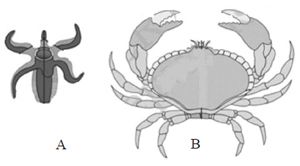
A. A : Biradial, organisms is divided into unequal halves by any plane through the central axis.
B. B: Bilateral, body is divided into equivalent right and left halves by only one plane.
C. A: Asymmetrical, organisms is not divided into equal halves by any plane through the central axis.
D. B: Radial, in which any plane passing through the central axis of the body divides the organism into two identical halves.
Answer : B

A. A : Biradial, organisms is divided into unequal halves by any plane through the central axis.
B. B: Bilateral, body is divided into equivalent right and left halves by only one plane.
C. A: Asymmetrical, organisms is not divided into equal halves by any plane through the central axis.
D. B: Radial, in which any plane passing through the central axis of the body divides the organism into two identical halves.
Answer : B
16. Refer the following statement and answer the question. 'Name of X is derived from stinging capsules. It exhibits metagenesis containing two body forms in which sessile and cylindrical form is called Y and umbrella shaped and free swimming is called Z. Identify X, Y, and Z.
A. X - Coelenterate, Y - Polyp, Z - Medusa
B. X - Cnidarian, Y - Medusa, Z - Polyp
C. X - Ctenophora, Y - Radula, Z - Hypostome
D. X - Porifera, Y - Osculum, Z - Radula
Answer : A
A. X - Coelenterate, Y - Polyp, Z - Medusa
B. X - Cnidarian, Y - Medusa, Z - Polyp
C. X - Ctenophora, Y - Radula, Z - Hypostome
D. X - Porifera, Y - Osculum, Z - Radula
Answer : A
17. Which of the following is a correct match of a phylum with their three examples?
A. PlatyhelminthesPlanaria, Schistosoma, Enterobius
B. Mollusca Loligo, Sepia, Octous
C. Porifera Spongilla, Euplectella, Pennatula
D. Cnidaria Bonellia, Physalia, Aurelia
Answer : B
A. PlatyhelminthesPlanaria, Schistosoma, Enterobius
B. Mollusca Loligo, Sepia, Octous
C. Porifera Spongilla, Euplectella, Pennatula
D. Cnidaria Bonellia, Physalia, Aurelia
Answer : B
18. Which of the following possesses poison sting and belongs to class chondrichthyes?
A. Labeo
B. Myxine
C. Clarias
D. Trygon
Answer : D
A. Labeo
B. Myxine
C. Clarias
D. Trygon
Answer : D
19. Hemichordates have now been placed with the nonchordates, close to echinoderms, because true
A. notochord is absent.
B. pharyngeal gill-slits are lacking.
C. dorsal nerve cord is absent.
D. heart is lacking.
Answer : A
A. notochord is absent.
B. pharyngeal gill-slits are lacking.
C. dorsal nerve cord is absent.
D. heart is lacking.
Answer : A
20. Which of the following animal contains respiratory organs like, gills, book gills, book lungs or tracheal system?
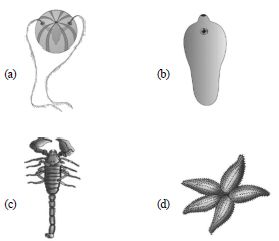
A. Click to check answer
B. Click to check answer
C. Click to check answer
D. Click to check answer
Answer : C

A. Click to check answer
B. Click to check answer
C. Click to check answer
D. Click to check answer
Answer : C
21. Which of the following statements (i - v) are correct ?
(i) The pelvic fins of female sharks bear claspers.
(ii) In Obelia, polyps produce medusae sexually and medusae form the polyps asexually.
(iii) Flame cells in platyhelminthes help in osmoregulation and excretion.
(iv) In non-chordates, central nervous system is ventral, solid and double.
(v) Pinnae are present in mammals.
A. (ii), (iv) and (v)
B. (i), (iii) and (v)
C. (iii), (iv) and (v)
D. (i), (ii) and (iii)
Answer : C
(i) The pelvic fins of female sharks bear claspers.
(ii) In Obelia, polyps produce medusae sexually and medusae form the polyps asexually.
(iii) Flame cells in platyhelminthes help in osmoregulation and excretion.
(iv) In non-chordates, central nervous system is ventral, solid and double.
(v) Pinnae are present in mammals.
A. (ii), (iv) and (v)
B. (i), (iii) and (v)
C. (iii), (iv) and (v)
D. (i), (ii) and (iii)
Answer : C
22. Few cnidarians like corals have a skeleton composed of
A. calcium hydroxide
B. calcium sulphate
C. calcium carbonate
D. sodium bicarbonate
Answer : C
A. calcium hydroxide
B. calcium sulphate
C. calcium carbonate
D. sodium bicarbonate
Answer : C
23. Which of the following statement(s) is/are correct regarding phylum mollusca?
A. They are bilaterally symmetrical, triploblastic and coelomate animals.
B. Body is covered by a calcareous shell and is unsegmented with a distinct head, muscular foot and visceral hump.
C. The mouth contains a file-like rasping organ for feeding, called radula.
D. All of the above
Answer : D
A. They are bilaterally symmetrical, triploblastic and coelomate animals.
B. Body is covered by a calcareous shell and is unsegmented with a distinct head, muscular foot and visceral hump.
C. The mouth contains a file-like rasping organ for feeding, called radula.
D. All of the above
Answer : D
24. Which of the following is a connecting link between invertebrates and non-invertebrates?
A. Sphenodon
B. Balanoglossus
C. Tadpole larva
D. Crocodile
Answer : B
A. Sphenodon
B. Balanoglossus
C. Tadpole larva
D. Crocodile
Answer : B
25. Which of the following is not a characteristic of phylum echinodermata ?
A. They have a water vascular system.
B. They have an internal skeleton.
C. They are protostomes.
D. They have bilateral symmetry at larval stage.
Answer : C
A. They have a water vascular system.
B. They have an internal skeleton.
C. They are protostomes.
D. They have bilateral symmetry at larval stage.
Answer : C
26. Heart is three - chambered in reptiles, except
A. turtle
B. Chameleon
C. Naja (Cobra)
D. crocodile
Answer : D
A. turtle
B. Chameleon
C. Naja (Cobra)
D. crocodile
Answer : D
27. The figure given below shows the germinal layers marked as A, B, C and D. Identify the label showing undifferentiated layer and its location?
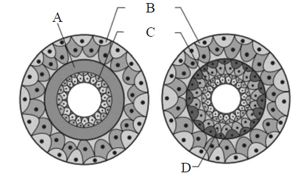
A. A, Between B & C
B. B, Between A & C
C. C, Between C & D
D. D, Between A & B
Answer : A

A. A, Between B & C
B. B, Between A & C
C. C, Between C & D
D. D, Between A & B
Answer : A
28. Which of the following statement(s) is/are correct regarding phylum aschelminthes?
(i) The body is circular in cross-section hence the name roundworms.
(ii) Alimentary canal is complete with a well-developed muscular pharynx.
(iii) Sexes are separate (dioecious), i.e., males and females are distinct.
(iv) Nephridia help in osmoregulation and excretion.
A. (i) and (ii)
B. (iii) and (iv)
C. (i), (ii) and (iii)
D. All of these
Answer : C
(i) The body is circular in cross-section hence the name roundworms.
(ii) Alimentary canal is complete with a well-developed muscular pharynx.
(iii) Sexes are separate (dioecious), i.e., males and females are distinct.
(iv) Nephridia help in osmoregulation and excretion.
A. (i) and (ii)
B. (iii) and (iv)
C. (i), (ii) and (iii)
D. All of these
Answer : C
29. Examine the figures A, B and C. In which one of the four options all the items A, B and C are correctly identified ?

A. A - Sycon, B - Euspongia, C - Spongilla
B. A - Euspongia, B - Spongilla, C - Sycon
C. A - Spongilla, B - Sycon, C - Euspongia
D. A - Euspongia, B - Sycon, C - Spongilla
Answer : A

A. A - Sycon, B - Euspongia, C - Spongilla
B. A - Euspongia, B - Spongilla, C - Sycon
C. A - Spongilla, B - Sycon, C - Euspongia
D. A - Euspongia, B - Sycon, C - Spongilla
Answer : A
30. Which of the following is a fresh water sponge?
A. Sycon
B. Euspongia
C. Spongilla
D. Pleurobrachia
Answer : C
A. Sycon
B. Euspongia
C. Spongilla
D. Pleurobrachia
Answer : C
31. Which of the following is not a chordate character?
A. Presence of paired pharyngeal gill slits
B. Ventral heart
C. Solid and ventral nerve cord
D. Presence of post-anal tail
Answer : C
A. Presence of paired pharyngeal gill slits
B. Ventral heart
C. Solid and ventral nerve cord
D. Presence of post-anal tail
Answer : C
32. When any plane passing through the central axis of the body divides the organism into two identical halves, the organism is called ___________.
A. radially symmetrical
B. bilaterally symmetrical
C. asymmetrical
D. metamerically segmented
Answer : A
A. radially symmetrical
B. bilaterally symmetrical
C. asymmetrical
D. metamerically segmented
Answer : A
33. Which of the following pairs of animals comprises jawless fishes?
A. Mackerals and rohu
B. Lampreys and hag fishes
C. Guppies and hag fishes
D. Lampreys and eels
Answer : B
A. Mackerals and rohu
B. Lampreys and hag fishes
C. Guppies and hag fishes
D. Lampreys and eels
Answer : B
34. Which of the following class is being correctly described by given statements (i - iv)?
(i) All living members of this class are ectoparasites on some fishes.
(ii) They have a sucking and circular mouth without jaws.
(iii) Circulation is of closed type.
(iv) They are marine but migrate for spawning to fresh water. After spawing, within a few days they die.
A. Cyclostomata
B. Chondrichthyes
C. Osteichthyes
D. Amphibia
Answer : A
(i) All living members of this class are ectoparasites on some fishes.
(ii) They have a sucking and circular mouth without jaws.
(iii) Circulation is of closed type.
(iv) They are marine but migrate for spawning to fresh water. After spawing, within a few days they die.
A. Cyclostomata
B. Chondrichthyes
C. Osteichthyes
D. Amphibia
Answer : A
35. Which of the following statement is incorrect?
A. Platyhelminthes has incomplete digestive system.
B. In coelenterates, the arrangement of cells is more complex.
C. Nereis is monoecious but earthworms and leeches ae dioecious.
D. Simple and compound eyes are present in the animals of those phylum whose over two-thirds of all named species on earth are arthropods.
Answer : C
A. Platyhelminthes has incomplete digestive system.
B. In coelenterates, the arrangement of cells is more complex.
C. Nereis is monoecious but earthworms and leeches ae dioecious.
D. Simple and compound eyes are present in the animals of those phylum whose over two-thirds of all named species on earth are arthropods.
Answer : C
36. Match the phylum given in column - I with the special features present in them given in column - II and choose the correct option.
A. A III; B IV; C V; D II; E I
B. A IV; B III; C V; D II; E I
C. A III; B IV; C II; D V; E I
D. A III; B V; C IV; D II; E I
Answer : A
| Column -I | Column- II |
|---|---|
| (Phylum) | (Special features present) |
| A. Porifera | I. Mammary glands |
| B. Mollusca | II. Cloaca |
| C. Ctenophora | III. Choanocytes |
| D. Amphibia | IV. Radula |
| E. Mammalia | V. Comb plates |
A. A III; B IV; C V; D II; E I
B. A IV; B III; C V; D II; E I
C. A III; B IV; C II; D V; E I
D. A III; B V; C IV; D II; E I
Answer : A
37. Refer the figures A, B and C and choose the correct option which shows animals that regulate buoyancy with the help of air bladder.
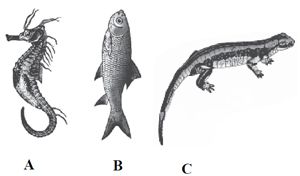
A. A and B
B. A and C
C. B and C
D. All of the above.
Answer : A

A. A and B
B. A and C
C. B and C
D. All of the above.
Answer : A
38. Which of the following is a living fossil?
A. Balanoglossus
B. Echinus
C. Ancylostoma
D. Limulus
Answer : D
A. Balanoglossus
B. Echinus
C. Ancylostoma
D. Limulus
Answer : D
39. A file like rasping organ for feeding, called radula, present in the phylum __________.
A. arthropoda
B. mollusca
C. echinodermata
D. chordata
Answer : B
A. arthropoda
B. mollusca
C. echinodermata
D. chordata
Answer : B
40. Which one of the following groups of animals is correctly matched with its characteristic feature without even a single exception ?
A. Reptilia : possess 3 - chambered heart with one incompletely divided ventricle.
B. Chordata : Possess a mouth provided with an upper and lower jaw.
C. Chondrichthyes : Possess cartilaginous endoskeleton.
D. Mammalia : Give birth to young one.
Answer : C
A. Reptilia : possess 3 - chambered heart with one incompletely divided ventricle.
B. Chordata : Possess a mouth provided with an upper and lower jaw.
C. Chondrichthyes : Possess cartilaginous endoskeleton.
D. Mammalia : Give birth to young one.
Answer : C
41. The given figures (A & B) shows the germinal layer. The animals having structures shown in the figures are respectively called

A. diploblastic, triploblastic
B. triploblastic, diploblastic
C. diploblastic, diploblastic
D. triploblastic, triploblastic
Answer : A

A. diploblastic, triploblastic
B. triploblastic, diploblastic
C. diploblastic, diploblastic
D. triploblastic, triploblastic
Answer : A
42. Which of the following is a poisonous snake?
A. Naja (Cobra)
B. Bangarus (Krait)
C. Viper (Viper)
D. All of these
Answer : D
A. Naja (Cobra)
B. Bangarus (Krait)
C. Viper (Viper)
D. All of these
Answer : D
43. Match the phylum given in column - I with their example given in column - II and choose the correct option.
A. A IV; B II; C I; D III
B. A II; B IV; C I; D III
C. A II; B IV; C III; D I
D. A II; B I; C IV; D III
Answer : B
| Column -I | Column- II |
|---|---|
| (Phylum) | (Examples) |
| A. Echinodermata | I. Ascidia, Doliolum |
| B. Hemichordata | II. Asterias, Ophiura |
| C. Urochordata | III. Branchiostoma |
| D. Cephalochordata | IV. Balanoglossus, Saccoglossus |
A. A IV; B II; C I; D III
B. A II; B IV; C I; D III
C. A II; B IV; C III; D I
D. A II; B I; C IV; D III
Answer : B
44. Which of the following statements (i v) are incorrect?
(i) Parapodia are lateral appendages in arthropods used for swimming.
(ii) Radula in molluscs are structures involved in excretion.
(iii) Aschelminthes are dioecious.
(iv) Echinoderm adults show radial symmetry.
(v) Ctenophorans are diploblastic.
A. (i) and (ii)
B. (i) and (iii)
C. (i), (iv) and (v)
D. (iii) and (v)
Answer : A
(i) Parapodia are lateral appendages in arthropods used for swimming.
(ii) Radula in molluscs are structures involved in excretion.
(iii) Aschelminthes are dioecious.
(iv) Echinoderm adults show radial symmetry.
(v) Ctenophorans are diploblastic.
A. (i) and (ii)
B. (i) and (iii)
C. (i), (iv) and (v)
D. (iii) and (v)
Answer : A
45. Which of the following is not a characteristic feature of kingdom animalia ?
A. Storage of carbohydrates as starch.
B. Multicellularity.
C. Obtaining nutrients by ingestion.
D. Having eukaryotic cells without walls.
Answer : A
A. Storage of carbohydrates as starch.
B. Multicellularity.
C. Obtaining nutrients by ingestion.
D. Having eukaryotic cells without walls.
Answer : A
46. The given figures A, B, C and D are the examples of first true land vertebrates. They are dominant in mesozoic era and belong to phylum ‘X’. Identify ‘X’ and the animals which have four chambered heart.
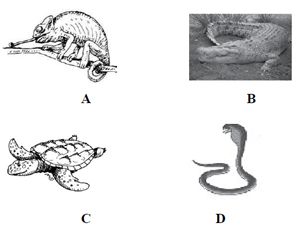
A. X – Reptile; B
B. X – Reptile; A
C. X – Amphibia, C
D. X – Pisces; D
Answer : A

A. X – Reptile; B
B. X – Reptile; A
C. X – Amphibia, C
D. X – Pisces; D
Answer : A
47. Read the following statements and answer the question.
(i) They are exclusively marine, radially symmetrical, diploblastic organisms with tissue level of organisation.
(ii) Body bears eight external rows of ciliated comb plates, which help in locomotion.
(iii) Digestion is both extracellular and intracellular.
(iv) Reproduction takes place only by sexual means.
Which of the following phylum is being described by above statements?
A. Platyhelminthes
B. Arthropoda
C. Mollusca
D. Ctenophora
Answer : D
(i) They are exclusively marine, radially symmetrical, diploblastic organisms with tissue level of organisation.
(ii) Body bears eight external rows of ciliated comb plates, which help in locomotion.
(iii) Digestion is both extracellular and intracellular.
(iv) Reproduction takes place only by sexual means.
Which of the following phylum is being described by above statements?
A. Platyhelminthes
B. Arthropoda
C. Mollusca
D. Ctenophora
Answer : D
48. Which of the following animals are bilaterally symmetrical?

A. 1 & 2
B. 2 & 4
C. 3 & 4
D. 1 & 3
Answer : B

A. 1 & 2
B. 2 & 4
C. 3 & 4
D. 1 & 3
Answer : B
49. Animals like annelids, arthropods, etc. where the body can be divided into identical left and right halves in only one plane, exhibit___________symmetry.
A. radial
B. bilateral
C. asymmetrical
D. non- symmetrical
Answer : A
A. radial
B. bilateral
C. asymmetrical
D. non- symmetrical
Answer : A
50. Which one of the following features is common in silverfish, scorpion, dragonfly and prawn?
A. Three pairs of legs and segmented body.
B. Chitinous cuticle and two pairs of antennae.
C. Jointed appendages and chitinous exoskeleton.
D. Cephalothorax and tracheae.
Answer : C
A. Three pairs of legs and segmented body.
B. Chitinous cuticle and two pairs of antennae.
C. Jointed appendages and chitinous exoskeleton.
D. Cephalothorax and tracheae.
Answer : C
Sharing is caring
Related Post
Java Programming MCQ Solved Paper for GMAT
Astronomy 1000+ MCQ with answer for RBI Grade B officer
1000+ C Programming MCQ for UPSC CSE [Solved]
Problems on Trains 1000+ MCQ with answer for SSC Scientific Assistant
1000+ Astronomy Multiple Choice Question Answer [Solved]
General Biology Set 2 MCQ Solved Paper for GMAT